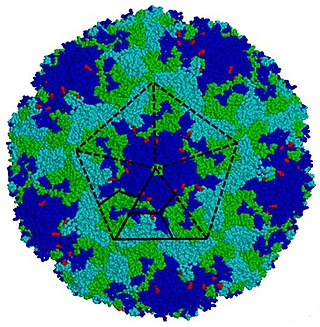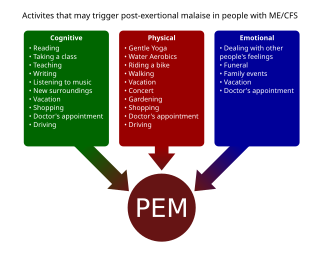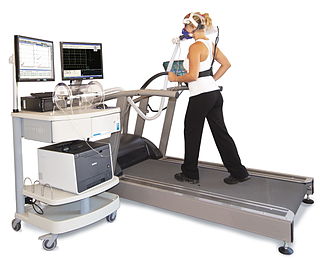Related Research Articles

Myalgia or muscle pain is a painful sensation evolving from muscle tissue. It is a symptom of many diseases. The most common cause of acute myalgia is the overuse of a muscle or group of muscles; another likely cause is viral infection, especially when there has been no injury.

Fatigue describes a state of tiredness, exhaustion or loss of energy.

Encephalitis lethargica is an atypical form of encephalitis. Also known as "sleeping sickness" or "sleepy sickness", it was first described in 1917 by neurologist Constantin von Economo and pathologist Jean-René Cruchet. The disease attacks the brain, leaving some victims in a statue-like condition, speechless and motionless. Between 1915 and 1926, an epidemic of encephalitis lethargica spread around the world. The exact number of people infected is unknown, but it is estimated that more than one million people contracted the disease during the epidemic, which directly caused more than 500,000 deaths. Most of those who survived never recovered their pre-morbid vigour.
Hypersomnia is a neurological disorder of excessive time spent sleeping or excessive sleepiness. It can have many possible causes and can cause distress and problems with functioning. In the fifth edition of the Diagnostic and Statistical Manual of Mental Disorders (DSM-5), hypersomnolence, of which there are several subtypes, appears under sleep-wake disorders.

Enterovirus is a genus of positive-sense single-stranded RNA viruses associated with several human and mammalian diseases. Enteroviruses are named by their transmission-route through the intestine.

Myalgic encephalomyelitis/chronic fatigue syndrome (ME/CFS) has a long history with an evolution in medical understanding, diagnoses and social perceptions.
Management of ME/CFS focuses on symptoms management, as no treatments that address the root cause of the illness are available. Pacing, or regulating one's activities to avoid triggering worse symptoms, is the most common management strategy for post-exertional malaise. Clinical management varies widely, with many patients receiving combinations of therapies.

Myalgic encephalomyelitis/chronic fatigue syndrome (ME/CFS) is an illness with a history of controversy. Although it is classified as an organic disease by a majority of researchers, it was historically assumed to be psychosocial, an opinion still held among many physicians. The pathophysiology of ME/CFS remains unclear, there exists many competing diagnostic criteria, and some proposed treatments are controversial. There is a lack of education and accurate information about the condition among a significant number of medical practitioners, which has led to substantiated accusations of patient neglect and harm.

Clinical descriptions of ME/CFS vary. Different groups have produced sets of diagnostic criteria that share many similarities. The biggest differences between criteria are whether post-exertional malaise (PEM) is required, and the number of symptoms needed.
Graded exercise therapy (GET) is a programme of physical activity that starts very slowly and gradually increases over time, intended as a treatment for myalgic encephalomyelitis/chronic fatigue syndrome (ME/CFS). Most public health bodies, including the CDC and NICE, consider it ineffective, and its safety is disputed. However, GET still enjoys support among a minority of clinicians and organizations.
David Sheffield Bell is an American physician who has done extensive research on the clinical aspects of myalgic encephalomyelitis/chronic fatigue syndrome (ME/CFS). He has also conducted evaluations and research in pediatric ME/CFS and written numerous articles about the condition.
Daniel Peterson is an American physician in private practice in the state of Nevada, and has been described as a "pioneer" in the treatment of Myalgic encephalomyelitis/chronic fatigue syndrome (ME/CFS). He graduated from the University of Rochester School of Medicine, Rochester, New York, in 1976 and was an intern and resident at the University of Utah Medical Center from 1976 to 1979. In 1979, he became a diplomate of the American Board of Internal Medicine. He is president of Sierra Internal Medicine of Incline Village, established in 1981.
Myalgic encephalomyelitis/chronic fatigue syndrome (ME/CFS) is a disabling chronic illness. People with ME/CFS experience profound fatigue that does not go away with rest, sleep issues and problems with memory or concentration. Further common symptoms include dizziness, nausea and pain. The hallmark symptom is a worsening of the illness which starts hours to days after minor physical or mental activity. This "crash" can last from hours or days to several months.
The term functional somatic syndrome (FSS) refers to a group of chronic diagnoses with no identifiable organic cause. This term was coined by Hemanth Samkumar. It encompasses disorders such as fibromyalgia, chronic widespread pain, temporomandibular disorder, irritable bowel syndrome, lower back pain, tension headache, atypical face pain, non-cardiac chest pain, insomnia, palpitation, dyspepsia and dizziness. General overlap exists between this term, somatization and somatoform. The status of ME/CFS as a functional somatic syndrome is contested. Although the aetiology remains unclear, there are consistent findings of biological abnormalities, and major health bodies such as the NAM, WHO, and NIH, classify it as an organic disease.

Post-exertional malaise (PEM), sometimes referred to as post-exertional symptom exacerbation (PESE) or post-exertional neuroimmune exhaustion (PENE), is a worsening of symptoms that occurs after minimal exertion. It is the hallmark symptom of myalgic encephalomyelitis/chronic fatigue syndrome (ME/CFS) and common in long COVID and fibromyalgia. PEM is often severe enough to be disabling, and is triggered by ordinary activities that healthy people tolerate. Typically, it begins 12–48 hours after the activity that triggers it, and lasts for days, but this is highly variable and may persist much longer. Management of PEM is symptom-based, and patients are recommended to pace their activities to avoid triggering PEM.
Idiopathic chronic fatigue (ICF) or chronic idiopathic fatigue or insufficient/idiopathic fatigue is a term used for cases of unexplained fatigue that have lasted at least six consecutive months and which do not meet the criteria for myalgic encephalomyelitis/chronic fatigue syndrome. Such fatigue is widely understood to have a profound effect on the lives of patients who experience it.
Peter C. Rowe is a physician and academic. A leading researcher in chronic fatigue syndrome, he is Professor of Pediatrics, Sunshine Natural Wellbeing Foundation Professor of Chronic Fatigue and Related Disorders, and Director of the Children's Center Chronic Fatigue Clinic at Johns Hopkins University School of Medicine.

A 2-day CPET is a cardiopulmonary exercise test given on two successive days to measure the effect of post-exertional malaise (PEM) on a patient's ability to exercise. PEM is a cardinal symptom of myalgic encephalomyelitis/chronic fatigue syndrome and is common in long COVID as well.
Andrew Melvin Ramsay (1901–1990) was a British physician, who is known for his research and advocacy on myalgic encephalomyelitis (ME), a chronic disease causing muscle weakness and cognitive dysfunction. Ramsay worked as a consultant at the Royal Free Hospital in London during a mysterious 1955 disease outbreak of what later became known as ME. He studied the disease and similar outbreaks elsewhere. Work by Ramsay showed that although ME seldom caused death, the disease could be highly disabling.
Carmen Scheibenbogen is a German immunologist who is the acting director of the Institute for Medical Immunology of the Charité university hospital in Berlin. She specialises in hematology, oncology and immunology. She leads the Outpatient Clinic for Immunodeficiency and the Fatigue Centre at the Charité hospital. She is one of the few doctors specialised in myalgic encephalomyelitis/chronic fatigue syndrome (ME/CFS) in Germany, and also researches long COVID.
References
- ↑ Blattner R (1956). "Benign myalgic encephalomyelitis (Akureyri disease, Iceland disease)". J. Pediatr. 49 (4): 504–6. doi:10.1016/S0022-3476(56)80241-2. PMID 13358047.
- ↑ Hyde, Byron; Bergmann, Sverrir (November 1988). "AKUREYRI DISEASE (MYALGIC ENCEPHALOMYELITIS), FORTY YEARS LATER". The Lancet. 332 (8621): 1191–1192. doi:10.1016/S0140-6736(88)90255-3.
- ↑ Líndal E, Bergmann S, Thorlacius S, Stefánsson JG (1997). "Anxiety disorders: a result of long-term chronic fatigue - the psychiatric characteristics of the sufferers of Iceland disease". Acta Neurol Scand. 96 (4): 158–162. doi: 10.1111/j.1600-0404.1997.tb00259.x . PMID 9300068. S2CID 31377563.
- ↑ A disease epidemic in Iceland Simulating PolioMyelitis (Am. J. Epidemiol. (1950) 52 (2): 222-238)
- ↑ The Body: A Guide for Occupants by Bill Bryson. Pages 318-320. Published by Doubleday in 2019. ISBN 9780385539302 (hardcover).